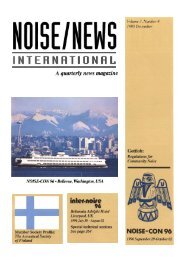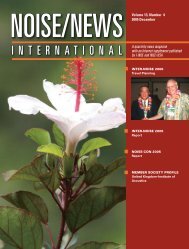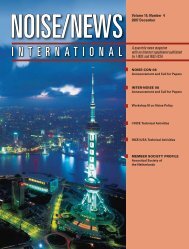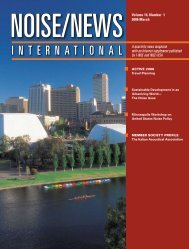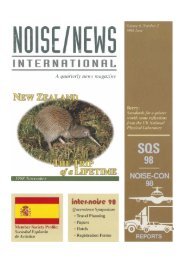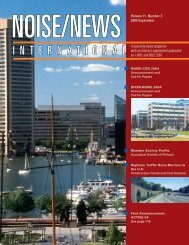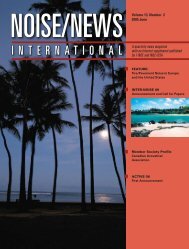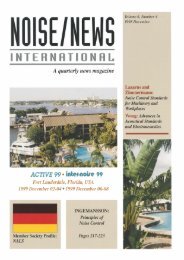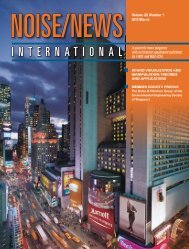Volume 14, Number 4, December, 2006 - Noise News International
Volume 14, Number 4, December, 2006 - Noise News International
Volume 14, Number 4, December, 2006 - Noise News International
Create successful ePaper yourself
Turn your PDF publications into a flip-book with our unique Google optimized e-Paper software.
• Manufacturers legally required to<br />
guarantee relevant noise emission limit<br />
values—the motivation is to develop<br />
low-price products which will be safe<br />
to use and have minimum impact on the<br />
environment.<br />
• Customers with a self-motivated<br />
interest in low-noise products—their<br />
goal is to purchase a quieter product at a<br />
competitive price.<br />
• Customers not educated in acoustics<br />
who should be encouraged to buy<br />
quieter products through product<br />
information emphasizing that low-noise<br />
products can be had without higher<br />
prices and by an easy-to-understand<br />
labeling system. One example of this<br />
is the energy consumption classification<br />
A, B, C... for refrigerators.<br />
Industry must have state-of-the-art<br />
knowledge of noise control techniques.<br />
This means the laws of noise generation<br />
for the different sound sources of their<br />
equipment (primary noise control) and<br />
methods for secondary<br />
noise control must be<br />
readily available. (The<br />
former requires a detailed<br />
knowledge of the physical<br />
interactions governing<br />
the noise generating and<br />
radiating characteristics of<br />
the components of a product<br />
during its development.)<br />
The teaching of machinery<br />
acoustics in the universities is extremely<br />
important for developing quiet products<br />
because it is through these courses that<br />
the techniques of primary noise control<br />
become available to industry.<br />
The objective of machinery acoustics is<br />
the numerical prediction of a product’s<br />
noise output using a relevant software<br />
package prior to the construction of a<br />
prototype. The inputs are machinery<br />
specific data (including operating<br />
conditions) and acoustical relationships<br />
(including flow patterns and internal<br />
forces). This is not a simple problem,<br />
but there is progress. For example, at<br />
the present time, the noise produced by<br />
magnetic forces within rotating electrical<br />
Low <strong>Noise</strong> Design<br />
Must Focus on the<br />
Primary Sources<br />
machines can be determined before the<br />
machine is manufactured.<br />
The major topics to be included in<br />
machinery acoustics are acoustical<br />
measurement techniques, generation of<br />
structure and fluid borne sound, sound<br />
radiation, and aerodynamically generated<br />
sound. Other subjects to be included in<br />
courses on machinery acoustics include:<br />
• legal requirements on product noise<br />
emissions<br />
• knowledge of international standards<br />
for measurements and test equipment<br />
• state-of-the-art research results on<br />
product noise emissions<br />
• participation by industry in research,<br />
consultation, and instruction<br />
Acoustical measurements produce noise<br />
emission data that industry needs to<br />
support the financial investment<br />
necessary to develop quiet products. This<br />
requires attention to the current<br />
measurement standards,<br />
especially for measurement<br />
uncertainties and<br />
verification procedures.<br />
New techniques for<br />
airborne and structureborne<br />
sound intensity<br />
measurement and noncontact<br />
vibration<br />
measurements by laser<br />
techniques, possibly<br />
assisted by robots, are important tools<br />
currently under development.<br />
Let me give examples where machinery<br />
acoustics provides noise control without<br />
increasing the price of the product.<br />
• For a rotating machine operating in air,<br />
the sound power radiated varies with<br />
the 5.5 power of its rotational speed but<br />
with only the first power of its length.<br />
Hence, reducing the rotational speed<br />
and increasing the length of the rotor is<br />
a cost-effective means of noise control<br />
in the design stage.<br />
• A second example is the cost-neutral<br />
construction of a fan in which the pure<br />
tone components of the sound radiated<br />
are suppressed by irregular blade<br />
spacing.<br />
For structure-borne sound radiation, the<br />
construction elements to be considered in<br />
machinery acoustics are arbitrarily shaped<br />
and the frequency range of interest extends<br />
up to about 8 kilohertz. The construction<br />
elements considered in structure-borne<br />
machinery acoustics differ from those in<br />
building acoustics where the elements are<br />
straight and plane, and the frequency range<br />
covered is more restricted. This means that<br />
machinery acoustics requires a description<br />
for structure-borne sound generation and<br />
radiation by all different shapes, if possible<br />
with the same equation that permits<br />
changes to be easily studied.<br />
The sound power is the principal quantity<br />
to describe the noise emission of a product.<br />
This means that the numerical methods for<br />
determining the sound radiation should be<br />
focused on the sound power of the machine.<br />
If possible, this should be done directly,<br />
not indirectly with the boundary-element<br />
method (BEM) or finite-element method<br />
(FEM). A solution for this is the so-called<br />
direct-finite-element method (DFEM).<br />
The challenge of machinery acoustics is<br />
to achieve noise control in a product by<br />
focusing the design on the primary sources<br />
and by applying physical laws to the sound<br />
generated by these sources, not by adding<br />
secondary elements that typically add cost<br />
to the product.<br />
Environmental noise<br />
reduction and global<br />
regulatory harmonization<br />
Kenneth Feith, U.S. Environmental<br />
Protection Agency, USA<br />
Our world is becoming noisier. Who is<br />
responsible? We are! What can be done?<br />
It is up to each one of us to think, teach,<br />
and buy quiet. Quiet products are on the<br />
market as a result of consumer demand as<br />
well as government regulation.<br />
What is the role of governments<br />
insofar as the noise issue is concerned?<br />
Governments are responsible for public<br />
health and welfare. They respond to<br />
<strong>14</strong>6 www.inceusa.org • www.noisenewsinternational.net • www.i-ince.org <strong>2006</strong> <strong>December</strong>



